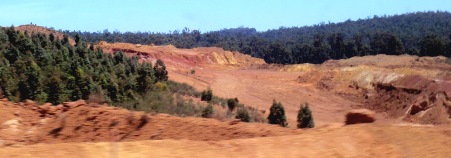 It comes as a shock to many bushwalkers to learn that much of the jarrah forests and wandoo woodlands of the northern Darling Range, including many areas the Club regularly walks near Perth, are destined eventually to be strip-mined for bauxite, or aluminium ore. The bauxite ore is recovered from below the thin, laterite caprock that covers most of the hilltops and low ridges. During mining the mature forest and laterite ‘pods’ are removed, often with their fringing ‘breakaway’ landscape, before the area is ‘rehabilitated’ with young replacement forest. With mined areas expanding at a rate of around 9.3 square kilometres per year, newly affected bushwalking areas will in the future stretch from Bannister Hill in the south to beyond Mount Dale in the north.
It comes as a shock to many bushwalkers to learn that much of the jarrah forests and wandoo woodlands of the northern Darling Range, including many areas the Club regularly walks near Perth, are destined eventually to be strip-mined for bauxite, or aluminium ore. The bauxite ore is recovered from below the thin, laterite caprock that covers most of the hilltops and low ridges. During mining the mature forest and laterite ‘pods’ are removed, often with their fringing ‘breakaway’ landscape, before the area is ‘rehabilitated’ with young replacement forest. With mined areas expanding at a rate of around 9.3 square kilometres per year, newly affected bushwalking areas will in the future stretch from Bannister Hill in the south to beyond Mount Dale in the north.
In the late 1970s, conservationists led an ultimately unsuccessful campaign against major expansion of the bauxite mining which had started at Jarrahdale in 1963. In today’s more conservation aware community it is unlikely that such vast tracts of breakaway landscapes and mature forest close to Perth would have been given up by Government to mining. But the Agreements with the miners signed then continue to be honoured by subsequent State governments. As mining operations expand further, access to more walk areas will be lost during - and for years after - the mining operations and so-called rehabilitation work is completed, while new forest is established on the modified landscape. The mining will continue for at least another 50 years; to 2066 under ALCOA’s lease terms and probably for as long as the low-grade ore remains profitable to mine.
|
|
What can the bushwalking community do? :
- We must aim for a good understanding of what and where the impacts on our walking areas have been and will be, and document these;
- We must respond to any plans affecting our walk areas whenever they come available for public comment, then communicate with those who can most influence outcomes, particularly the miners themselves, so they are aware of the specific impacts on our bushwalking areas; and
- We must try to work with the miners so that: i) forest roads giving access to our walk areas are kept open; ii) mining plans retain attractive breakaway landscape plus sizeable pockets of original forest wherever possible; iii) vegetation buffers are preserved to screen operations; and iv) blasting noise and dust emissions from sites close to walk areas are minimised or timed.
As Perth’s population continues to grow, there will be growing community pressure for access to the nearby Darling Range for more quality bushwalking opportunities beyond the Bibbulmun Track and the national parks. If we are proactive, perhaps walkers in generations to come will be more likely to find that walking in some of the rehabilitated areas could offer an enjoyable – albeit forever changed – bushwalking experience.

(This is an edited extract from “Bauxite vs bushwalking” – article by then Club President, Dave Osborne in WILD magazine, issue #138, Nov.-Dec 2013.)